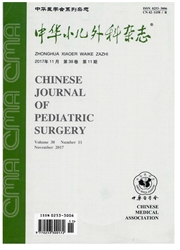

 中文摘要:
中文摘要:
目的通过dishevelled-1(DVL-1)和dishevelled-3(DVL-3)基因及其相关蛋白在先天性巨结肠症(Hirschsprung's disease,HD)中表达水平的研究,探索DVDl和DVD3与HD的发病关系。方法利用荧光实时定量PCR(quantitative real-time polymerase chain reaction, qRT-PCR)、蛋白质印迹(Westernblot)和免疫组织化学方法检测50例HD患儿狭窄段(无神经节细胞)和正常段(有神经节细胞)肠管组织DVL-1和DVL-3的表达情况,并对其表达进行定量分析与比较。结果DV卜1在HD狭窄段肠管中mRNA表达量是正常段肠管中的2.06倍;DVD3在HD狭窄段肠管中mRNA表达量是正常段肠管中的3.12倍,差异有统计学意义(P〈0.03)。Westernblot结果显示,DVDl在HD狭窄段肠管中蛋白相对表达量为39.71±4.53,高于正常段肠管蛋白表达量为15.01±2.66,差异有统计学意义(P〈0.05);DVD3在HD狭窄段肠管中蛋白相对表达量为53.90土6.79,高于正常段肠管蛋白的表达量20.13±3.63,差异有统计学意义(P〈0.05)。免疫组化结果显示,DVDl和DVD3在HD狭窄段肠管的黏膜层细胞胞质内呈强阳性反应,呈深棕黄色,而在HD正常段肠壁的黏膜层细胞胞质内呈阴性或弱阳性反应,无色或淡黄色;此外,研究还发现,与正常段的神经丛相比,狭窄段肠管中异常增生的神经纤维组织内DVL-3的表达信号更强。结论DVD1和DVD3mRNA与蛋白在HD狭窄段肠管中高表达,提示DVD1和DVL-3与HD的发生有密切关系,可能在先天性消化道畸形的肠道发育中具有重要作用;DVD3可能成为今后临床诊断HD一项参考指标。
 英文摘要:
英文摘要:
Objective To evaluate the expression of dishevelled-1 (DVL-1) and dishevelled-3 (DVL-3) genes and proteins in the aganglionic and normal segment of colon in patients with Hirschsprung's disease (HSCR). Methods The expression of DVL-1 and DVL-3 genes were detected by quantitative real-time polymerase chain reaction ( qRT-PCR ), Western blot and immunohistochemical staining in the aganglionic and normal segment of colon in 50 patients with HSCR. Results The mRNA expression of DVL-1 and DVL-3 was 2. 06 fold and 3. 12 fold in the aganglionic segment colon tissues compared to the normal segment, respectively. Similarly, the protein expression of DVL-1 and DVL-3 was higher in the stenotic colon segments than that in the normal segment (39.71 ± 4.53 vs. 15.01 ± 2.66; 53.90 ± 6.79 vs. 20. 13 ± 3.63, respectively). Besides, immunohistochemical staining showed that the expression of DVL-1 and DVL-3 significantly increased in the mucous and submucous layers from stenotic colon segments compared to the normal segments. Conclusions Higher expression of DVL-1 and DVL-3 mRNA and protein in the stenotic colon of HD suggests that DVL-1 and DVL-3 are involved in the pathogenesis of HE). DVL-3 may become a reference index for clinical diagnosis of HD in the future.
 同期刊论文项目
同期刊论文项目
 同项目期刊论文
同项目期刊论文
 期刊信息
期刊信息
